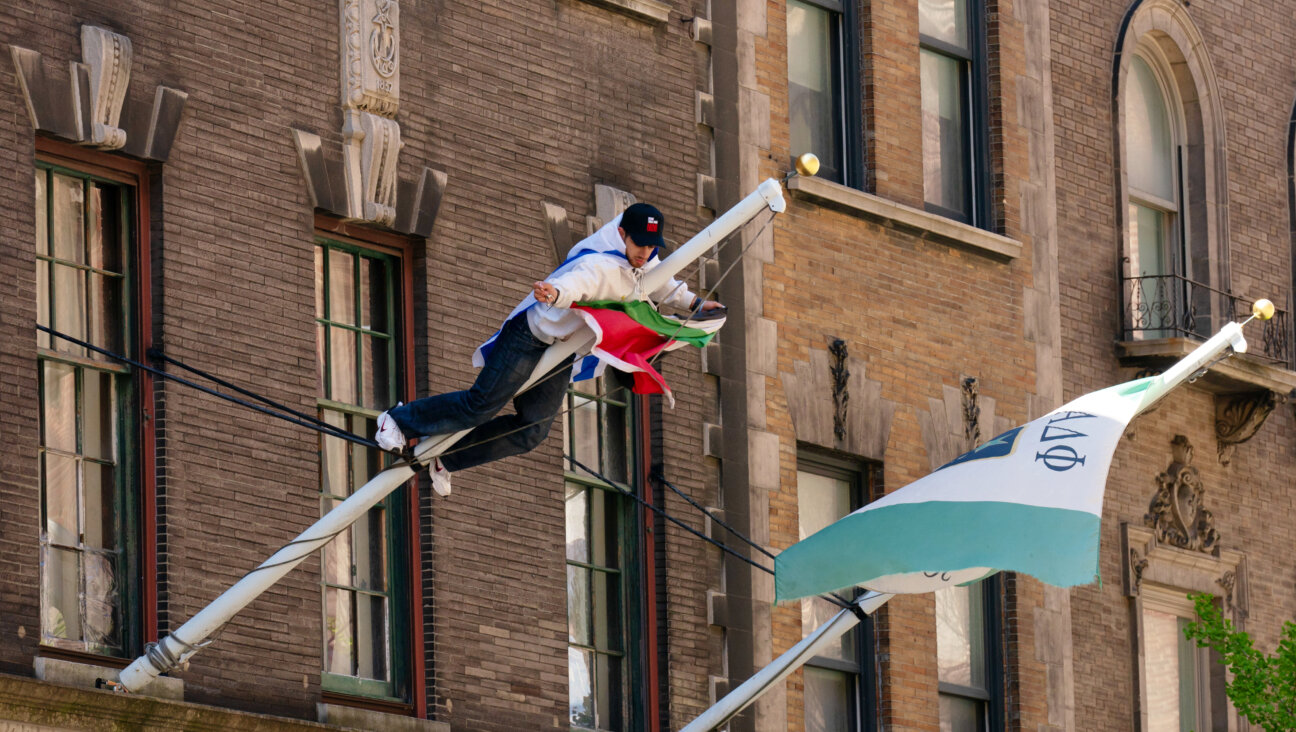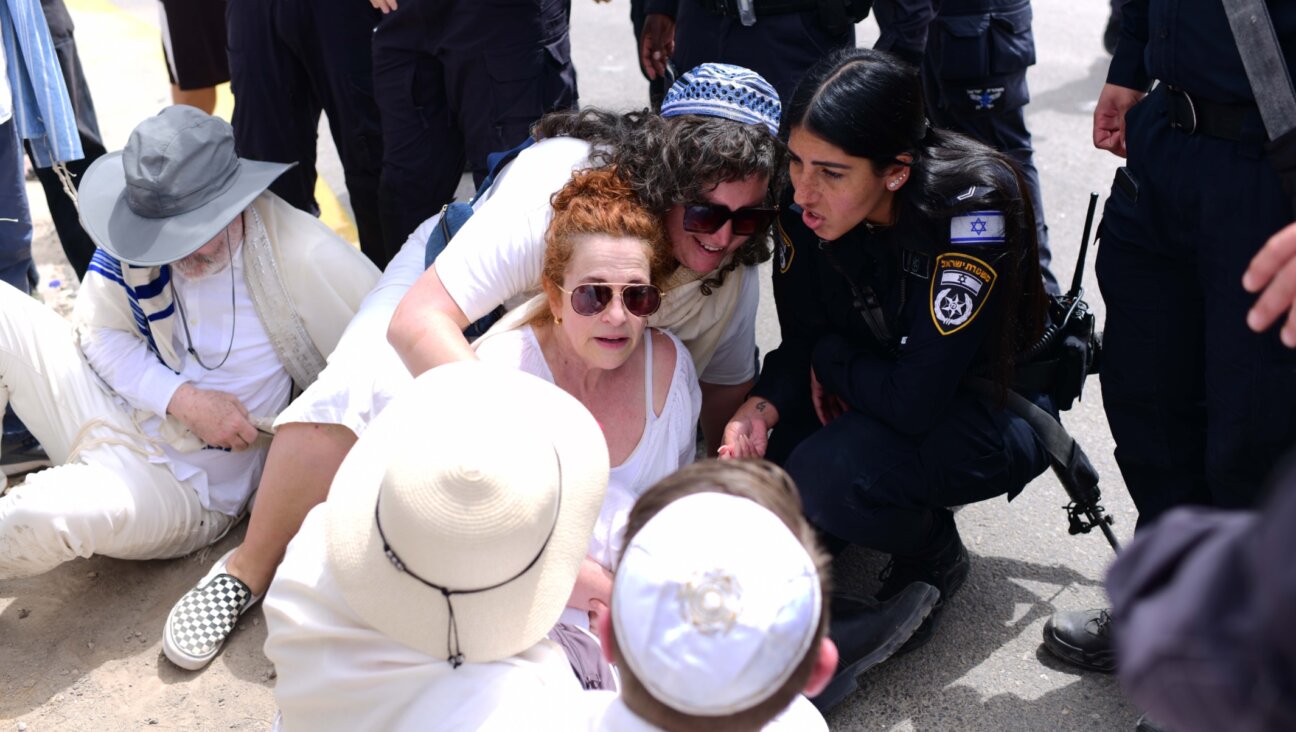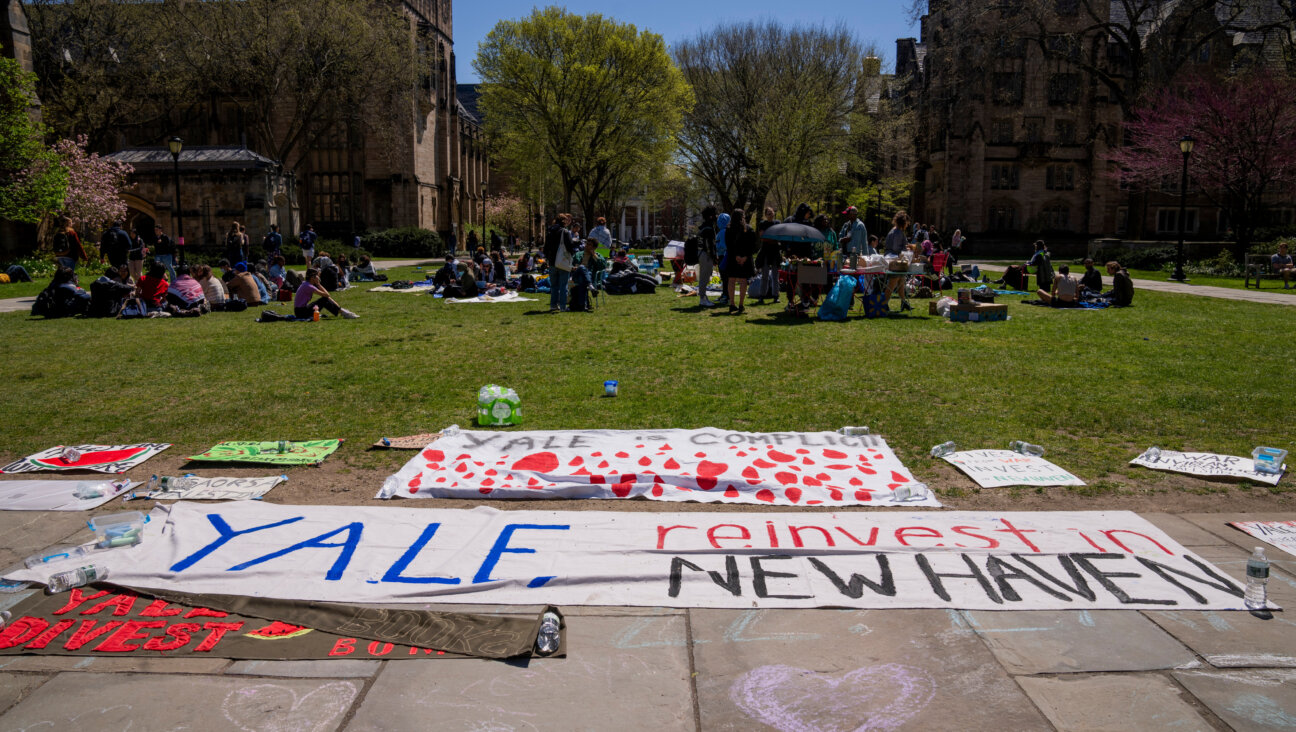Why Is a Formerly Secular Woman Like Her Running a Chabad Center?

Keren Blum with her family at their home in Manhattan. Image by Martyna Starosta
At the age of 13, Keren Blum told her parents that she was an agnostic. Because she also became a vegetarian at that time, her parents, Conservative Jews, were troubled by what they perceived as rebelliousness. They tried to make Judaism joyous and meaningful for her — in vain, at least initially.
Blum completed her undergraduate degree at Hampshire College in Amherst, Massachusetts. During her college years she ran Necessities Necesidades, a domestic abuse hotline and women’s shelter in Northampton, and wrote a thesis on the nutritional healthcare of pregnant women suffering from HIV.
But her parents had never quite given up on their daughter’s return to Judaism. When she was 19, her mother asked the local Chabad rabbi to reach out to her daughter. He invited Blum to a Shabbat dinner at the Chabad House in Amherst. At the same time, a friend struck a bargain with her. If Blum was willing to attend a weekly class about Hasidism, she would get involved in the women’s center on campus.
One dinner led to another. As she listened to the Chabad teachers and read the books on the shelves, she encountered a Judaism that she could identify with: “It blew my mind. The Conservative Judaism I knew talked about rules and lifestyle and had no meaning,” said Blum, 40, wearing a sheitel, a loose-fitting top and mid-calf length skirt, in the converted brownstone near Columbia University that serves as the university’s Chabad center. She has been co-running it with her husband Yonah Blum for 18 years.
The Chabad-Lubavitch movement, a branch of Hasidism, has been around for more than 250 years and now boasts over 5,000 emissary couples or shluchim, such as the Blums, whose mission is outreach and education. They serve an array of populations from students to seniors to people with special needs, as well as new niches as teenagers and young Jewish professionals.
Most Chabad-Lubavitchers are born into it, but Keren Blum is not nearly as anomalous as one might think. There are no surveys or statistics on how many female and male Chabad members are newcomers, but insiders suggest that it is a substantial number. While the growing number of centers has increased Chabad’s exposure, the question of what appeals to women, such as Blum, who were far removed from the Chabad tradition, persists.
Newcomers and those flirting with Orthodoxy are encouraged to enroll in classes on the history and traditions of the Hasidim, but there are no formal entrance exams required for outsiders. Nor do special rituals mark the occasion. The desire to live a Torah-observant life as part of the Chabad community is the only “requirement,” and the four newcomers I interviewed to speak about their choices and experiences recalled being embraced with open arms.
“Many of these women are drawn to tight-knit communities and the structure they provide,” said Sarah Bunin Benor, author of “Becoming Frum: How Newcomers Learn the Language and Culture of Orthodox Judaism.” “This is especially true for those who feel their lives are unstructured. Some have experienced a major life event and turned to spiritual movements and religions that may not be their own, from Christianity to Eastern religions. In the ’60s and ’70s, it was not uncommon for members of the counter-culture to end up as Orthodox Jews. Fans of the Grateful Dead became Orthodox.”
Chabad’s intellectual bent might also attract educated women — and men — such as Blum, said Baila Olidort director of communications at Chabad Headquarters in Crown Heights. “They are in good positions to serve as emissaries, identifying with others who have not grown up with Jewish tradition and they may have better instincts when it comes to distilling and communicating Chabad’s ideas,” she said.
Rebbetzin Simcha Fine, who has been co-running Montreal’s Chabad Community Center with her husband Rabbi Ronnie Fine for 34 years, said that as an adolescent she felt a lack of consistency and meaning in her nominally Conservative Jewish background. Her family kept kosher at home only. “I didn’t get that,” she said. “It was a missing link.”
When she was 12, her father took her and her 15-year-old sister to a Chabad service in their hometown of Long Beach, California. While he enjoyed it, he was no convert. By contrast, the sisters were intrigued. They attended services and Hebrew School, and grew close to the rabbis and their families. Within three years, they were both Torah-observant Jews, a step their parents were not too happy about.
“They were worried about the restrictive life,” said Simcha Fine, who spoke on the phone from Montreal. “But they see how happy I’ve been, so they’ve changed their minds. And it didn’t hurt that they got a lot of grandchildren out of the deal.”
The women faced major challenges —losing friends and, in some instances, family members who didn’t know quite how to react to their new identities. Still, Blum of Columbia University Chabad admitted she felt bad that her former friends were no longer comfortable with her since she continues to feel comfortable with them.
Miri Birk, who works under Rabbi Eli and Chana Silberstein, the directors of Chabad at Cornell University, grew up in a Reform Jewish household in the Fairfax, Virginia area. As a teenager she was a competitive horseback rider, and participated in the Junior Olympics; even after she matriculated at the University of Virginia in Charlottesville, she had her sights set on competing in the Olympics.
When a fellow horseback rider invited her to a Shabbat dinner, Birk, then 19, was receptive to what Chabad offered. She was already feeling a gap between her politics and that of her Reform synagogue, and felt alienated by the discussion of social activism during services. “I wondered what gun control had to do with Judaism,” she said on the phone from Ithaca, New York. She was also losing patience with the moral relativism voiced by her professors and the way they celebrated open-mindedness on every viewpoint short of those they didn’t agree with. She was also troubled by what she saw as the secular feminists’ rejection of the idea that motherhood should be a priority in their 20s.
“Women were pushed to pursue careers in their 20s that were incompatible with marriage and child-rearing, but at the same time, I was seeing women in their late 30s and 40s unable to have children they always wanted and were promised would still be available to them,” she said. “Something just didn’t add up.”
For some of the women I spoke with, meeting with Chabad women for the first time represented turning a point.
“When I met the Rebbetzin, who had nine kids, I couldn’t believe it,” said Bracha Leeds, 31, who is now a rebbetzin herself. She co-runs Chabad at UC Berkeley and has five kids. “I expected a woman with nine kids to be in a wheelchair. Aside from how well she looked, she was so energetic and alive.” Formerly a musical theater performer specializing in hip-hop, Leeds joined Chabad at 18 and majored in molecular cell biology at Berkeley.

Keren Blum with her family at their home in Manhattan. Image by Martyna Starosta
Blum, who also has five children, said she never had any desire to be a mother. “I couldn’t stand the noise and I wanted to spend my free time with friends or my husband or reading.” She added that not having children would have been the biggest mistake of her life.
Serving as wife and mother is the Hasidic woman’s central role, the women said. It’s the home — not the synagogue — that is the center of Chabad-Lubavitch life. Not one of the interviewees said they felt discriminated against because Hasidic women don’t lead public prayer services or participate in minyans. “You need 10 men to create a minyan and be in the presence of God, but a woman accomplishes it on her own,” said Blum.
The Chabad community is not a natural setting for those who choose to remain single. Getting married in one’s early 20s or even younger is a goal. The women with whom I spoke quickly met their spouses, none of whom was born into Chabad either, through friends or casual social events. Only Fine was formally introduced to her husband through a shadchan, or matchmaker. Still, she stressed that Chabad is not into “arranged marriages,” but rather “arranged dating”: When Chabad children are in their late teens, parents ask around, do research on eligible partners and make introductions. Sometimes a matchmaker is brought into the picture. “But no one is forced into anything,” she said.
Asked how they’d react if a child of theirs wanted to marry a non-Jew, didn’t want to get married at all, or turned out to be lesbian, gay, bisexual or transgender, they all voiced broad-minded perspectives. Said Blum: “I’d continue loving them, not only in words, but actions too, and don’t delude myself into thinking I control anyone’s choices but my own.”
Simi Horwitz received a 2015 New York Press Club award for entertainment writing for the article she wrote for the Forward, “Gender and Ethnic Identity Politics in Theater: Jewish Drag Queens and Kings.”

I hope you appreciated this article. Before you go, I’d like to ask you to please support the Forward’s award-winning journalism this Passover.
In this age of misinformation, our work is needed like never before. We report on the news that matters most to American Jews, driven by truth, not ideology.
At a time when newsrooms are closing or cutting back, the Forward has removed its paywall. That means for the first time in our 126-year history, Forward journalism is free to everyone, everywhere. With an ongoing war, rising antisemitism, and a flood of disinformation that may affect the upcoming election, we believe that free and open access to Jewish journalism is imperative.
Readers like you make it all possible. Right now, we’re in the middle of our Passover Pledge Drive and we still need 300 people to step up and make a gift to sustain our trustworthy, independent journalism.
Make a gift of any size and become a Forward member today. You’ll support our mission to tell the American Jewish story fully and fairly.
— Rachel Fishman Feddersen, Publisher and CEO
Join our mission to tell the Jewish story fully and fairly.
Only 300 more gifts needed by April 30























